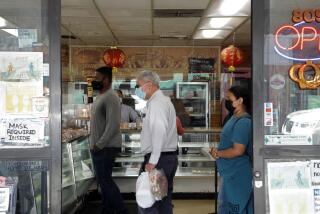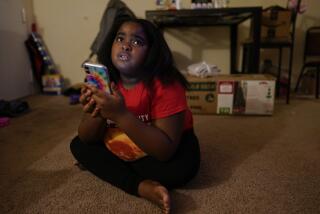Whooping cough still with us, still dangerous
- Share via
Two days after her second son, Dylan, was born in 2005, Mariah Bianchi let out yet another deep-chested cough, this time in the hospital, where she was recovering from the delivery.
She had been coughing for two weeks; she had coughed so badly that her contractions started early.
A pediatrician checking Dylan heard Bianchi’s bark-like cough — and a subsequent whooping sound as she gasped for air. The doctor told Bianchi it sounded like whooping cough, also called pertussis, and urged her to see her own doctor once she left the hospital.
She did so. But that physician listened to her lungs, she says, and then dismissed the possibility. Whooping cough was a disease of the past, the San Francisco woman recalls the doctor saying.
The doctor told her to keep breast-feeding and to wash her hands and gave her some inhalers to control lung spasms caused by what was believed to be a cold.
Two weeks later, Dylan was dead. He was 17 days old.
An autopsy found that Dylan died of a massive infection of the bacterium Bordetella pertussis, which causes whooping cough. Bianchi said she infected both Dylan and her older son, Cole, then 31/2. Cole too became seriously ill but survived.
Bianchi, a critical care nurse in San Francisco, doesn’t know when, or from whom, she contracted the disease, only that she had been vaccinated as a child.
“It happened so fast,” she says.
The death of Bianchi’s son highlights one of the chief problems confronting California health officials trying to stem a current upswing in the disease: Whooping cough is easily misdiagnosed, especially in its early stages.
The disease is both highly infectious and can quickly kill infants exposed to it. Four newborns, all younger than 3 months, have died in California so far this year, an alarming number to health officials because it already exceeds last year’s total of whooping cough-related deaths, three.
Rarely suspected
Bianchi encountered a variety of doctors and medical personnel in the latter days of her pregnancy — when she’d already developed a cough. Dylan encountered others after he was born. Only one, it seemed, suspected that his mother had pertussis. But even that suspicion failed to elicit corresponding preventive or treatment measures.
Newborns, or infants younger than 3 months, can have deceptively mild pertussis symptoms: a runny nose, an undetectable or mild cough, and generally no fever, said Dr. James D. Cherry, a UCLA pediatrics professor and a pertussis expert. But they can deteriorate rapidly.
They can begin to cough so much that they fail to get enough oxygen. Pneumonia can set in. The bacterium itself releases a toxin that can raise white blood cell levels so high that they begin to clog blood vessels, interfering with the body’s ability to bring oxygen into the blood.
The organs can then start to fail.
Most infants contract the disease from family members, usually the mother, health experts say. But the disease is frequently missed in adults. Many doctors have the mistaken belief that grownups simply don’t have whooping cough.
“I’ll give a talk somewhere and people will say, ‘Oh, adults don’t get pertussis,’” Cherry said. Instead, physicians often end up ordering unnecessary X-rays and body scans in an attempt to diagnose symptoms that, to them, seem puzzling.
Many adults believe they’re immune, having been vaccinated against the disease as a child. But immunity to whooping cough can begin fading five years after an inoculation.
Booster shots have now become an important part of public health officials’ attempts to combat the disease. Their strategy, called “cocooning,” requires that everyone around the baby be immunized to protect the infant, who is most threatened by pertussis in the first year of life.
The “cocoon” strategy was made possible with the approval in 2005 of a pertussis booster vaccine for adults and adolescents. Previously, booster shots were available only for children.
That vaccine was not yet in widespread use when Bianchi was pregnant in 2005.
“I wish a million times we could do things differently,” Bianchi said. “But there’s nothing I can do except tell my story.”
A tiny life lost
Almost two weeks after leaving the hospital, Dylan became so lethargic that he began falling asleep before completing feedings. The next day, she took him to his pediatrician, who sent them to the hospital for an X-ray to check if Dylan had pneumonia.
But then, she says, “every hour after that, he got worse and worse.”
Dylan became dehydrated and was soon transferred to the intensive care unit. His belly began to puff up. Respiratory therapists continuously tapped Dylan’s chest, trying to help him breathe. He was attached to a breathing tube. The measures did little good.
He wasn’t getting enough oxygen. Soon, his kidneys began to fail. Then his heart. He started turning blue.
Two days after being admitted to the hospital, Dylan was transferred to UC San Francisco; doctors hoped to hook him to a heart-lung bypass machine that would oxygenate his blood. Minutes after he arrived, however, he stopped breathing. Doctors began CPR, continuing it for 40 minutes.
Finally, the doctors brought Bianchi and her husband in to see their son as they continued performing CPR.
“You just see this little, tiny 8-pound baby, who is just so sweet. The sun was shining through the window. The hair was auburn color. He was kind of bluish. And it just looked like his life was gone,” Bianchi said.
The doctors halted resuscitation efforts.
Bianchi sat in a room that overlooked San Francisco.
“And we just held him. And that was it,” Bianchi said.
A call to awareness
Health officials say physicians should be aggressive about considering whooping cough as a possible diagnosis and report suspected cases to the public health department.
“They just don’t think about it, and we really want them to think about it, especially with adults who are around infants,” said Kathleen Harriman, a state epidemiologist.
Had a physician diagnosed Bianchi early and treated her with antibiotics, “her baby would be alive,” said Dr. Susan Fernyak, director of communicable disease control and prevention at the San Francisco Department of Public Health.
Bianchi is now finishing up a master’s degree in health policy at UC San Francisco’s Department of Nursing and in the fall will begin a doctoral program in health policy, studying the reasons why some parents are reluctant to vaccinate their children.
Bianchi said more people should learn about, and get, the pertussis booster.
“This is a serious disease. This is not just a regular cough that you get with a cold. This is really dangerous for babies,” Bianchi said. “Let’s protect our babies. Let’s vaccinate ourselves.”
If she had known she had whooping cough, she said, “I wouldn’t have held him and kissed his face.
“It just takes one breath.”







